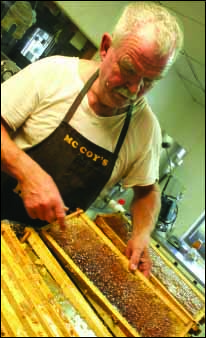Honey Harvesters Hail Sweet Product Of Hives
By LIBBY CUDMORE • allotsego.com
For Otsego County beekeepers like John McCoy, fall is the sweetest time of the year – the honey harvest.

(Ian Austin/AllOTSEGO)
McCoy, owner of McCoy’s Pure Raw Honey, overlooking Oneonta from Route 28, is in the middle of what the industry calls “extraction” – he collects over 2,000 frames from his nine beekeeping locations throughout Otsego County and culls the sweet nectar he built his business on.
“This year, we’ve got a lot of goldenrod honey, mixed with a little of the knotwood,” he said as he placed the dripping frames in the extractor. Bees were buzzing everywhere. “It turns it dark, but it’s delicious honey.”
After the dripping frames are collected from the hives, McCoy puts them first into a machine designed to “uncap” the honey comb. “Bees seal each cell with wax,” he said. “This scrapes off all the wax.”
The wax is collected in a vat underneath, which is spun for up to two hours to separate out any additional honey. The wax is then sent to a plant where it is cleaned, processed and pressed into blocks, which McCoy sells to sealant, cosmetic and candle makers.
Now uncapped, the frames – dripping honey freely – are put into an extractor. “It’s like a Ferris Wheel,” said McCoy. “The extractor spins, and the honey comes flying out.”
Twenty-one frames can fit into the extractor at one time, with each extraction yielding up to 60 pounds of honey. The honey runs down into a sump tank, then is pumped through a filter into a larger bulk tank. From there, 55 gallon drums are filled and the honey is bottled and sold.
“When I was in junior high, I did a science fair project on bees,” he said. “I took that project to the Otsego County Fair and won $10, then went down to Montgomery Ward and bought my first hive.”
A printer by trade, he has turned an avocation into a business since he retired more than a decade ago.
In August, McCoy put up the summer honey, which comes from wildflowers, strawberries, raspberries and sweet clover. “You can’t tell the bees to go to just one flower,” he said. “They go wherever they like.”
But he admits that this year’s summer yield wasn’t as strong. “You can have the best, healthiest bees, but if the flowers aren’t producing, there’s nothing you can do. Mother Nature is in charge of all that.”
He lost a lot of bees in the particularly cold winter, and is concerned about the effect Genetically Modified seeds will have on future yields. “Monsanto has a lot of control over this,” he said. “And it’s not good for the bees – or for us.”
But the fall honey harvest has brought bounty. “We average about 10 tons of honey total.” he said.

